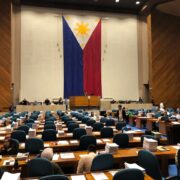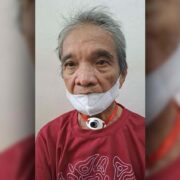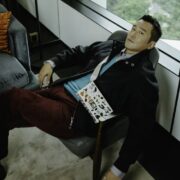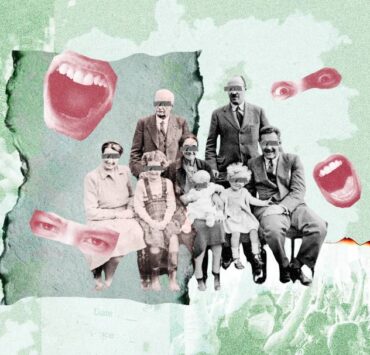Now this art exhibition is something truly audacious
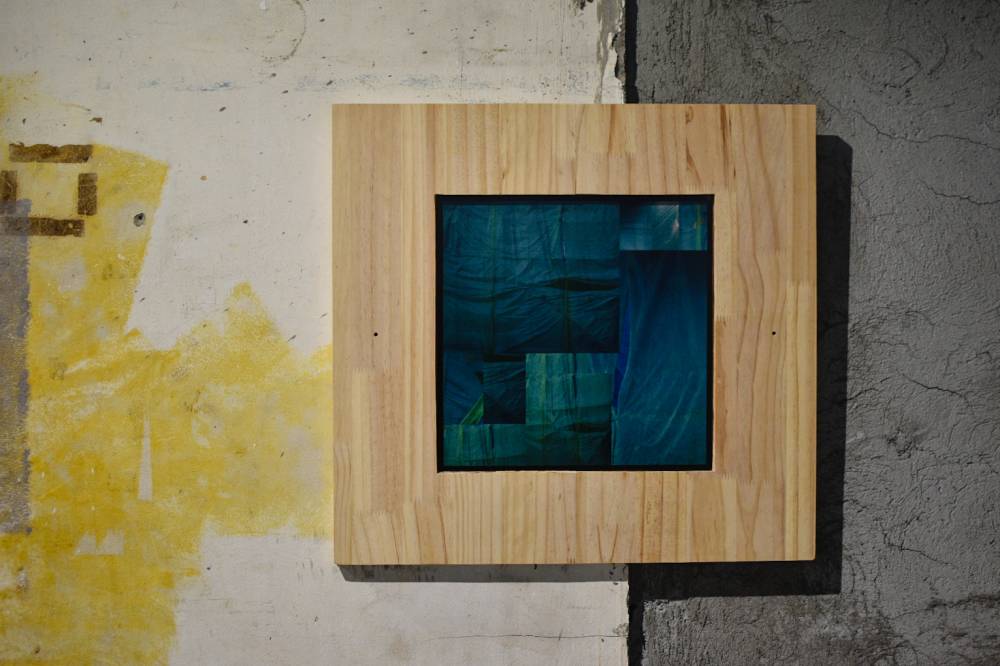
Most of the time, RCBC Plaza is just your typical corporate plaza that’s sleek, busy, and built for business. But lately, the building has been drawing a new crowd that seems curious and eager to see what contemporary art looks like when stripped of white walls and formalities.
Last May, an abandoned office floor was transformed into an exhibition that broke down traditional white walls with “Here & Now & Now & Then,” curated by Nilo Ilarde. This October, the same raw space welcomed a new kind of boldness with “Audacity,” a group show of over 20 artists curated by Chloe Magpayo.
“When I first saw the space, I thought, ‘This is audacious,’” Magpayo recalls. “It also felt right to call the show ‘Audacity’—such a jump from my last one (‘Dear Future Me’) in terms of scale, concepts, and artists.”
The vast, unfinished space allowed her to invite a range of artists to push their own boundaries. “I’ve really been leaning into materiality and those pushing the envelope of their own practice,” she says. “I believe deeply in their work.”
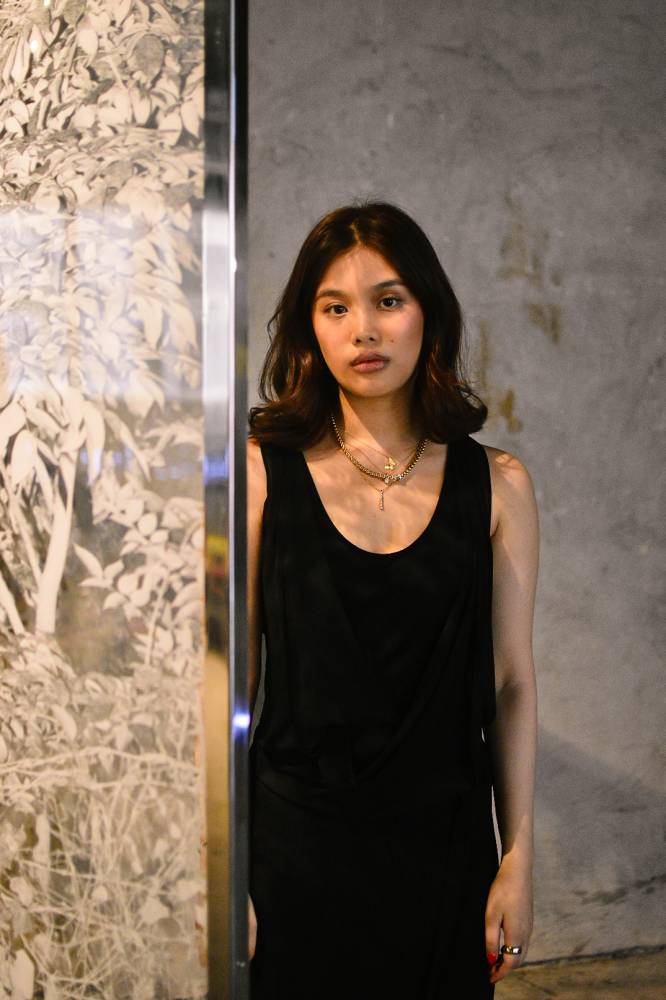
The artists and the different risks they take
Walking in, you first encounter works from Isabel and Alfredo Aquilizan’s Fruitjuice Factory Studio, including their daughter Amihan’s “Nest”—a birdcage-like assemblage of cardboard flowers mixing Philippine and Australian flora, reflecting on migration and belonging. Her sister Aniway adds a text-based piece underneath it, grounding the concept of both home and displacement.
Flanking this, Matt Trinidad documents his daily bike route turned construction zone in a panoramic photo collage that exposes displacement caused by urban expansion. Parallel, Kristoffer Ardeña’s community project features paintings on found fabrics made with local collaborators. When light seeps through, new textures appear, echoing the memory of shared labor.
You won’t miss the largest installation by Fruitjuice Factory sprawling across the floor: reconstructed signage from former Max’s Fried Chicken restaurants, glowing letters scattered across salvaged school benches.
Across it, Christina Lopez exhibits elegant portraits in leather, depicting blown-up portraits generated by AI, with the texture and stitches mimicking skin.
Nearby is “Untitled (Mimics, 3),” the third collaborative work of Lopez, Marty Carsi Cruz, Hideki Ito, and Bienvenido Tamayo. The atmospheric soundscape mimics synthesized audio, arranged in a flow, inviting viewers to walk through and experience its shifting layers.
Turn the corner and Mano Gonzales’ meditative lightboxes appear, their surfaces painstakingly pricked by hundreds of pinholes. Magpayo recalls how the repetitive process was “therapeutic and deliberate” for the artist, “speaking to fragility and memory.”
Each section feels like its own small world. One is devoted to Marionne Contreras, whose multicolored textile works are hung and layered at varying levels, asserting womanhood’s dynamic potential through fabric work. Nearby, Luis Antonio Santos presents two works: a botanical apparition of white-ink on plexiglass and “Tremor,” a neon bolt standing upright.
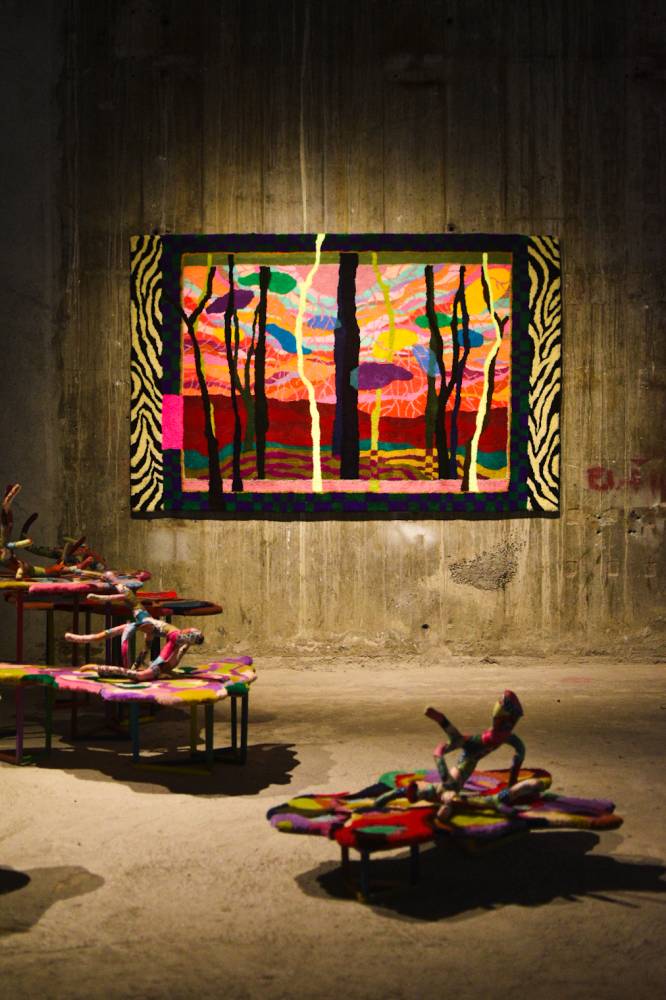
James Clar revisits a past work, “Taking a Ride With My Best Friend,” which shows a bricolage of a found car door under multicolored projection mapping—the shifting lights conjure images of drives with friends, scenery slipping by.
Within the bigger space are smaller quarters. “This is the Doktor Karayom room,” Magpayo states, gesturing into the space where Karayom turns inwards. He shows new paintings and an on-site mural of a body connected to a sculptural, lit-up head hanging upside-down, titled “Pabaliktad Kung Umiyak.”
Outside, Denver Garza’s usually wall-bound pieces now hang like suspended dreamcatchers. Painted, stitched, and freely spinning, Garza’s work mirrors his background as a mental health worker. Nearby, Maricar Tolentino’s embroidered curtain panels show nude self-portraits, raw and unfiltered. “She’s a discovery,” Magpayo says. “To depict her own body so openly, at this scale—it’s brave, it’s audacious.”
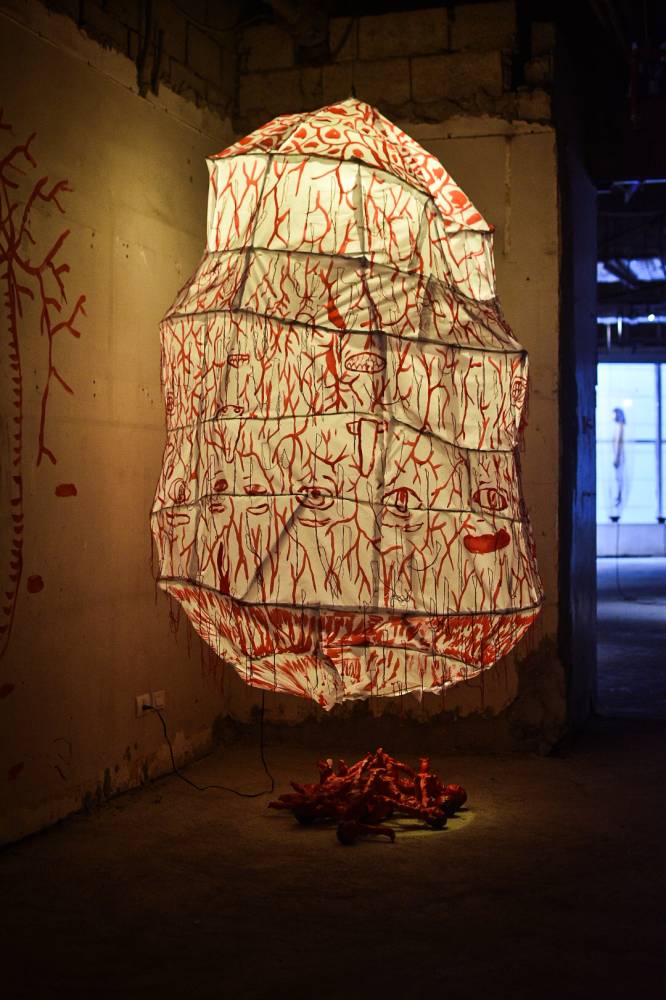
Sites, stories, and shifting realities
Other works engage the city itself: Brisa Amir’s rubbings of Quezon City’s Krus na Ligas neighborhood preserve traces of a community before gentrification. Also shown is a multicolored work from her series of “Slow Paintings.”
In the second small room, the curation seems to follow an otherworldly tone. Zeelah Aquilizan installs miniature houses into the space’s unfinished cement. The small homes evoke impermanence, makeshift homes, and the resolute resilience of the Filipino.
Further in, Lesley-Anne Cao’s polished metal boxes glint in silver, both delicate and deliberate. Facing them, Marco Santos’ “Flow State” spreads across the wall in gel, paint, epoxy, and burned surfaces, creating a forced chemical calm with a surface that both repels and attracts.
In between is Miguel Lorenzo Uy’s work: a retrofitted server-monitor looping a multicolored video projection of Morse code coordinates that blink in time with an inner fan. “He won’t say where,” Magpayo furtively says.
Rhaz Oriente also contributes a clever site-responsive piece. She maps RCBC’s relation to global remittance flows around the world. Pulsing lights trace the data routes of overseas Filipino workers, while beside it, text fragments read like poetry referencing banking institutions with the color of their background.
I’ve been missing most of the shows of Bianca Carague, so to see it in person was refreshing. Carague imagines a genomic squid from the year 2080 in a sculptural creature that straddles extinction and evolution as well as a video work. Another AR-enabled silk print brings her surreal environments to life.
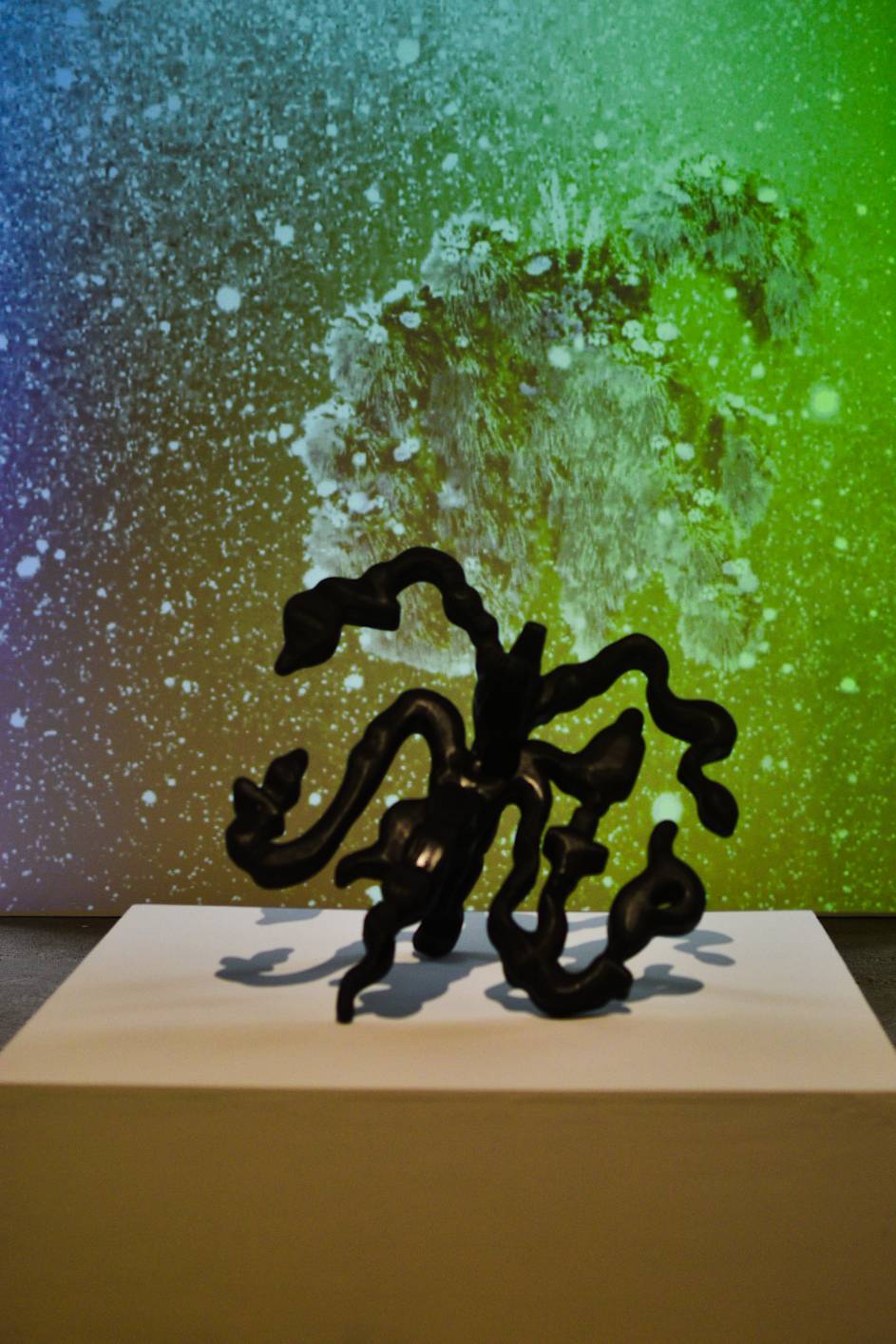
The array of works is dizzying. Costantino “Cos” Zicarelli mounts a series of wood panels shaped like computer monitors. The imagery references “The Gentle Tasaday,” a Lumad tribe thought to be isolated from the Stone Age, but later revealed as a hoax. Magpayo explains how Zicarelli nods to how narratives mutate over time, much like misinformation today.
In a small work, Zoraya Lua exhibits a photo-print on metal and wood that captures an underpass near her home. The image shows the contrast of the worlds above and below, with vendors and traffic underneath, wealth and concrete above.
The Tinapak River project of Vien Valencia also appears here in an impressive installation, filling another nook with videos and stacked, layered rubbings from river stones collected between 2023 and 2025, showing nature’s shifting forms.
Across, surrounding a sizable column, is Judy Freya Sibayan, whom Magpayo rightly calls “the OG audacious artist.” She presents magazine cutouts and artist books that question labor and survival in art’s economy. During opening night, she conducted performance art with Cao and Poklong Anading.
Coming to the end, Datu Arellano uses strips of unexpected material—vintage Playboy magazines and hentai manga—to explore taste and taboo. The raw material is clearly audacious, and the results were surprisingly in dialogue with a rust-leak installation nearby.
Finally, at the end of RCBC’s unfinished hall, Derek Tumala’s video work shows the shape of a dagger. Fire ants swarm to form the blade, referencing how the non-native species of ants—brought in by Spanish colonizers—reflect the persistent survival of Filipinos. The piece points back toward the show’s entrance, coming full circle.
A brave and clever show
After speaking with Magpayo, we ran into artists Raffy Napay and Neil Pasilan, who were shocked to learn that the curator is only 27 years old. They expected someone older, and rightly so, as the show flows with confidence, cohesion, and a willingness to experiment, altogether suggesting experience well beyond her years. In response, Magpayo humbly credits her “lovely install team” from Underground Gallery and gallery manager Oriente, who wrangled logistics in a space with few outlets and many challenges.
While “Audacity” is a word that seems loud, the show seems to prove that bravery can be communicated more gently, with persistence to push the envelope, be it via visual materials, memory, or community.
And in this raw, concrete floor at the center of a corporate building, “Audacity” claims bravery without provocation, taking shape not as noise, but more as clarity.
“Audacity,” curated by Chloe Magpayo and organized by Marco Santos, Teddy Catuira, and Bianca Bauer, runs from Oct. 25 to Nov. 14 at RCBC Plaza Podium 3 Tower II, Buendia Ave. corner Ayala Ave., Makati City




